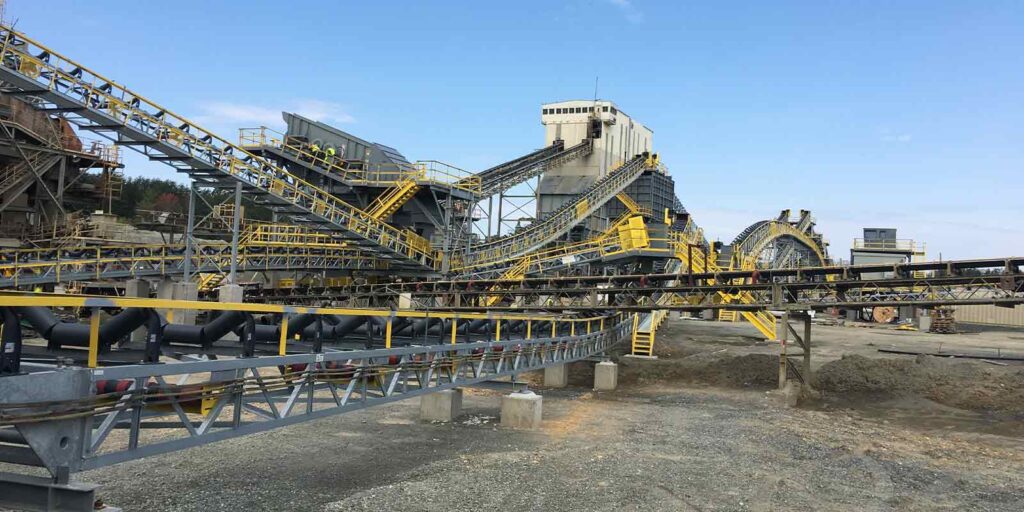Setting up a crushing plant means digging a deep hole.
The literal component of this is obvious. But the physical depth of the site is matched by investments in time, labor, and resources that are just as deep as the crushing pit itself. With a major financial investment to begin operations, crushing plants start from behind and must dig their way out to generate a profitable return.
If they aren’t set up correctly, they’ll be starting even further down and digging out will be much harder.
All of this means that the setup phase at a crushing plant is critical to get right. Here are eight tips to make that happen.
1. Set up the plant at the right time.
The best season to set up a crushing plant is in the fall. The weather is typically temperate enough for crews to work consistently, unlike summer or winter, which can pose dangers from the heat or cold.
Spring can work as well but in areas such as the east coast, there tends to be more rainfall during the first half of the year, which can impede the progress of setup and result in costly delays.
When possible, set up your crushing plant in the fall.
2. Plan with pre-fit parts.
This is standard practice but worth detailing: plan the construction of the plant down to the last bolt before starting the actual setup.
At Mellott, we manufacture all site components at our facilities, ensuring that everything is pre-fit and as constructed as possible before being shipped out to the crushing site. Our engineers are experienced in designing plants as well to ensure everything will run without slowdown.
3. Coordinate the delivery with the setup.
To maximize efficiency during the plant setup process, it’s important to coordinate delivery of the plant components so that work can happen on schedule.
This may mean 30 to 50 semi loads being delivered to a site. It will mean delivering any equipment that’s necessary in helping set the plant up first.
A worst-case scenario is a poorly planned delivery process, where people are left standing around waiting for the tools that will enable them to start setup or where there’s only one task able to be worked on and ten workers at the site.
Delivery can be complicated. It must be planned out in coordination with the setup to avoid lost time.
4. Set up one frame at a time.
We’ve found that focusing on completing one frame at a time expedites the setup process.
There’s some appeal to the idea of working on multiple frames simultaneously – this approach could, in theory, be more efficient if it was carried out perfectly. In practicality, it results in disorganization. Working on five frames at once is like working on five different cars at once in one garage; there will be disparate parts and pieces everywhere, and it’ll be hard to tell where any machine is in the process.
Focusing on one frame at a time results in a more ordered approach, with tasks that are achievable in clear sequences. Additionally, getting a frame finished is a morale booster. Teams appreciate having clear accomplishments to pursue.
Set up each frame in its entirety with all accessories before beginning the next step.
5. Coordinate the logistics of setup to avoid bottlenecks.
This point is critical in ensuring setup doesn’t expend unnecessary resources. It’s important to coordinate things so that work can happen efficiently.
For example, we typically don’t bring electricians to a site for wiring until two frames have been completed. When the electricians do arrive to work on the wiring, construction continues simultaneously on other items. This way, when the electricians finish their work on the two finished frames, there is more work for them to do.
In other words, no individual should be forced to sit and wait because a task isn’t achievable or because a process hasn’t been well-ordered.
6. Do dust suppression and dump boxes after setup.
Instead of building dust suppression and dump boxes during the setup process, it’s best to set up these components during the testing phase – after construction is complete.
The rationale is simple: if you build these components too soon, you won’t know exactly where spillage will hit or where dust will be.
7. Test for two days.
After setup is completed, we run 50% of material capacity over a two-day period to ensure that all systems, machines, and components are working as expected.
During testing pay attention to any points of transfer. These are the places where inefficiencies in the setup will be most obvious and damaging.
8. Check interlock.
Finally, as part of the testing process, check all interlocks to make sure that the system can be halted at any point if needed.
Don’t Dig a Deep Hole Without Planning Well
A crushing plant is a deep investment. Don’t dig deep without planning well. Follow these tips for setup to ensure that your plant can reach a place of productivity and positive return as efficiently as possible.
And if you want help, Mellott, we can consult with you on custom plant design, fabrication, and setup to ensure that your plant is as efficient and effective as possible, so that you can maximize your results.

